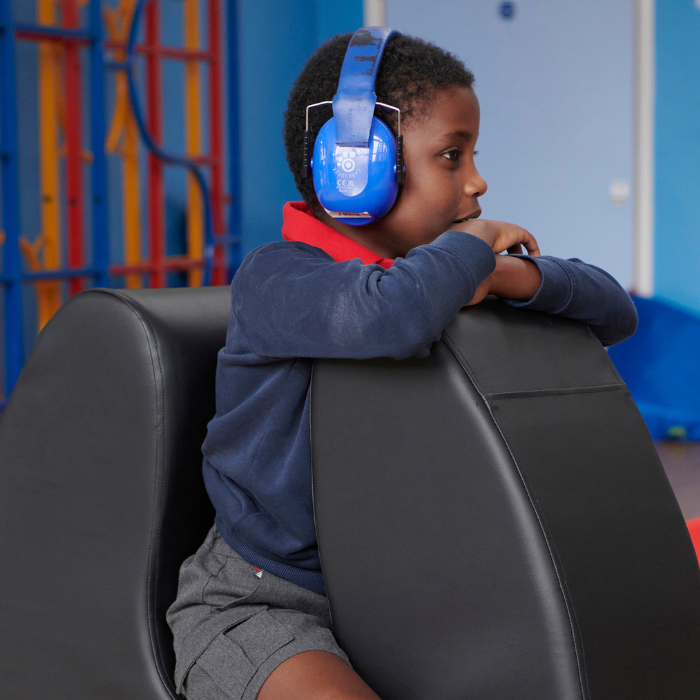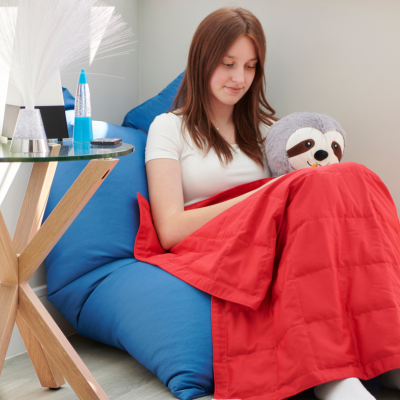Get exclusive deals you won't find anywhere else straight to your inbox.

3 Ways To Help Control Chewing in the Classroom
Chewing and biting on objects is not uncommon in students with Autism, ADHD or Sensory Processing Disorders. It is usually harmless, and can help reduce anxiety, calm, improve focus on activities and provide much needed sensory input.
In a classroom setting students often chew clothing such as sleeves, harder objects such as pencils or they may chew fingers and backs of hands. This is not always ideal, and can lead to soggy sleeves, sore fingers, as well as chewed pens and pencils. In this blog we look at ways you can help your students control their chewing habits, whilst still getting the sensory feedback they are seeking. We'll also suggest some safer, alternative chewing products, and resources that can alleviate anxiety or stress related chewing.
1 - Why Are Students Chewing Clothing?
There may be many reasons why your students are chewing on their clothes. Understanding the reasons and highlighting potential triggers can help you to provide appropriate solutions. It may well be by eliminating some of these triggers, that the frequency or desire to chew is reduced. Remember that each student is different therefore the solution will differ too.
Oral Sensory Input
One of the most common reasons that autistic children and adults chew is because they are seeking oral sensory feedback. If this is the case with some of your students, then their clothing might provide comfort and a texture that they enjoy to chew or mouth. The scent of a particular washing powder or the smell of home might make them feel comforted, more relaxed and closer to loved ones.
Lack Of Resources
Look around your classroom. Do students have access to alternative chewable resources such as sensory chews? If not, they will naturally seek out chewable items such as clothes, fingers, hands or even pencils to chew on instead.
Environment
Classrooms can be very loud, unpredictable places that can be distressing for some. If the classroom environment is too much, this can trigger sensory overload, where students feel anxious, frightened or confused. The familiarity and comfort of chewing on hands, fingers or clothing may alleviate anxiety and the action of chewing can help them concentrate and focus on one particular task, when the world around them may be too much to deal with.
Under-Stimulated
Dare we say it, boredom! Some students may start chewing clothing if they are feeling restless, irritable or bored. Chewing on something that they shouldn't such as clothing may be exciting and if they aren't fully engaged with classroom activities or not particularly enjoying a topic, they may seek to do this instead.
2 - Offer Safe Alternatives To Chewing Clothing
One quick and easy way to reduce chewing clothes or hands is to offer safe alternatives.
Sensory Chews
Sensory chews are designed to provide a safe alternative to chewing on fingers or clothing. They can satisfy the need to chew in a safe and appropriate way. Choose from a range of different sensory chews to suit individual students such as, chews on a safety lanyard, a bangle around the wrist, chewable tubes for pens and pencils or discreet tags for older children and teenagers.
For additional sensory feedback you can also try introducing a sensory chew whilst sitting on a peanut ball. Why not opt for a peanut ball with tactile nodules, just like this student did at a local school.

Comfort Scart
Sometimes students like to chew on shirt collars or jumper shoulders which can be especially uncomfortable when they get wet. Comfort scarfs are a safer, more practical solution and can be easily incorporated into the classroom. The soft, absorbent material is comfortable to wear and has a velcro fasterning which releases quickly and safely when required.

Protective Cuffs
If a student is used to repetitively chewing on their cuffs, it may be difficult to stop the action of chewing something on a wrist. Instead, why not opt for protective cuffs. These can be worn over shirt sleeves and chewed in a safe manner. You could also try a bangle instead if you're looking for a more discreet option.

Hand and Wrist Covers
Similar to protective cuffs, you could introduce hand and wrist covers. These are designed to fit across the back of the hand and wrist, to stop chewing on hands and clothing. You can also buy them with weights. This helps provide proprioceptive feedback to the hands and wrists, great for working on handwriting or fine motor skills.

Comfort Safety Lanyards
Another easy to introduce product are our comfort safety lanyards. We've long been asked for a 'chewable lanyard' that provides oral sensory feedback AND is safe to chew. So we listened and got to work designing just that product! The result is our new comfort safety lanyards - chewable, absorbent and comfortable safety lanyards.
Available in a pack of 3 (so there's always a spare) they're made from soft, absorbent terry towelling material. Safe to chew on their own or use with either a Chewbuddy™ Stickman or Chewbuddy™ Pl!ng chew.

3 - Create A Sensory-Friendly Environment
It's important to have a calm, low-stimulation area for your students, to help reduce anxiety induced chewing and encourage self-regulation. This can be in the classroom or a dedicated sensory space, where students can go when they feel anxious or overstimulated.
Sensory Dens
Pop up sensory dens are a great cost-effective and portable solution. They can be moved around to different areas or rooms as different students require access to them. Why not add some sensory mood lights or a bubble tube to create a calming, sensory environment to help reduce anxiety and sensory overload from the classroom.
Weighted Therapy
Some students benefit from additional sensory input through weighted items. The deep pressure received from the weight can help you feel grounded, calmer, and reduce anxiety-driven chewing. Try weighted blankets or laps pads. Available in a range of weights and fabric choices, including wipe-clean, they are great for classroom use.

Conclusion
Try helping your students stop chewing on their clothes and hands using these 3 steps;
- Identify the reason why they are chewing their clothing
- Provide them with alternative safe solutions
- Make sure they have access to a sensory-friendly environment to help self-regulate
If you have any tips or advice on how you help your students stop chewing on their clothes then we'd love to hear from you. Please get in touch at info@sensorydirect.com or contact us via facebook or instagram.
By Andrew Caws
Managing Director of Sensory Direct & Parent of an Autistic Adult
October 2024

